
Return to home page Read January 2007 blog Read December 2006 blog
Go to my 2001-2 Australia travel book
Send a comment
Other blogs I'm reading: Christine Allen's // Gordon Price's // Sarah Jane's photo site

We've moved to the Elizabeth Flats, Flat 3, 21 Warialda Street, Katoomba, NSW 2780. I could wish you could see it from Sublime Point, and thus we would have a fantastic view, but instead our view is just of the trees that surround our place, a grove of eucalypts and pines that is clearly visible from this viewpoint south of Leura. There is a separate web page with more pictures of our new home and its surroundings.
| February 27, 2007: Some
of the new expressions are cool as. I mean, they're cool as.
Which means you don't complete your similes, so something can be clever
as, or boring as. But the bad news, just as I've gotten used to talking
like that, is I see it on a car ad on the TV, which must mean it's dead
as. February has been a very changeable, quite wet month. Last night there was a deluge again over near the coast, with local flooding and train delays for commuters for an hour or so (we got about 30 mm in my Lee Valley rain gauge, which I brought from Canada). People say it's the wettest month of the year and are looking forward to March, which begins the autumn season (people don't say "fall" at all) and the stabilization of the weather into a calmer, clearer pattern. About 10 days ago, on a Saturday morning when we were out doing our usual garage sale round, we stopped by the Country Women's Association hall in Leura, the town to the east, where a bazaar and sale was taking place. The women inside were knitting "woolly jumpahs" -- sweaters, that is -- and one commented to Christine that she'd "need one soon." She then went on to say that, in her opinion, there could be 9 months of autumn and 3 of winter. Obviously not a fan of the heat. The last month has reminded me more of summers in eastern Canada than the placid weather of the Vancouver area. Bright sunny mornings and days that become hot, tending to humid, with massive clouds building in the sky as the afternoon passes. Many days there'd be a thunderstorm, with fantastic lightning followed a split second later by thunder ripping across the sky like the Jimi Hendrix guitar riffs on Electric Ladyland on widely spread stereo speakers. An obscure cultural reference, perhaps, but accurate. The thunderclap at the end of the rip is a pulse of energy that flexes the windowpanes. Everyone in the Blueys has a story about a fridge or a TV being blown up by electrical surges during storms, so you develop a habit of turning off the power at the "power point" -- the outlets all have switches on them -- when the lightning gets close. And if you go away, as we did down to Sydney over Friday night, you turn off computers, modems, stereos and TVs before you leave. But is it hot in Katoomba compared with Sydney? No way. If a day at the coast or in the city gets to 30, it will be 36 in the western suburbs at the base of the Blue Mountains, but only 25 here. And in the rain that often follows a thunderstorm, the clouds fill the valleys and drape across Katoomba in a chilly shroud. Definitely cool as. |
| February 25, 2007: Australians
love a competition, as evidenced by how well they do in international
sporting events, tennis, Olympics and so on. It shouldn't then be much
of a surprise to find that much of the art world runs around
competitions, too. Friday, the country's attention turned to the
biggest art
prize, the Archibald (it's a great
website to check out), whose finalists were
announced. It's quite a big deal with, for example, every one
of the dozens of paintings reproduced in the Weekend
Australian. The Archibald is the prize for portraiture, and with its overtone of the celebrity of some of the sitters it gets more attention than the Wynne, for landscape painting, or the Sulman for genre or mural painting. Everybody has an opinion about the entries and pays attention to the results, whereas they'd likely give little notice to art matters for the rest of the year. Gallery attendance is huge; the show subsequently travels to galleries around the country. The Archibald has been going for 85 years, due to a bequest by its namesake, the publisher of the Bulletin newspaper in Sydney. The winner, chosen by the trustees of the Art Gallery of New South Wales and given $25,000, is rarely uncontroversial, especially in the past half-century when modern styles have reduced the realism (and often the likeness) of the images and ever more of the pictures may or may not have been done from photos (the rules state that the subject has to sit for the portrait). But to counteract the high-art judgements of the experts, the packers (the blokes who unpack and hang the paintings) have their own prize, which tends to go to a more realistic image -- this year, a portrait of the actor Jack Thompson. The winner will be announced next week, providing a suitable diversion from the Oscars. I have my subject picked out for next year (but will have to have resident status to enter). |
February 21, 2007: I've
been reflecting on our fellow Katoombans, or Blue Mountaineers,
vis-à-vis my earlier comment about it reminding me of
the Gulf Islands and/or the Kootenays. Those earlier thoughts were
mainly about the landscape, but also mentioned the diversity of the
people. If there's a counterculture in Australia, it's here, coexisting
cheerfully with the Aussies in their shorts and knee socks and (not on
the same Aussie) flower-print frocks. Some marvellously weatherbeaten
and pony-tailed old hippies share the sidewalks with the tourists at
the cafes on Katoomba Street and the locals, most of whom carry bright
green canvas bags for their purchases as they scuttle from shop to
shop. Mixed among them are numbers of obviously poor people, none of
whom appear to be homeless or, except for a few flute or guitar-playing
buskers, panhandling. You can honestly say it's a more diverse place
than most Sydney (or Vancouver) neighbourhoods, as there's such a range
from rich to poor.
The strip of classifieds below from the Blue
Mountains Gazette seemed to sum up their main enthusiasms.
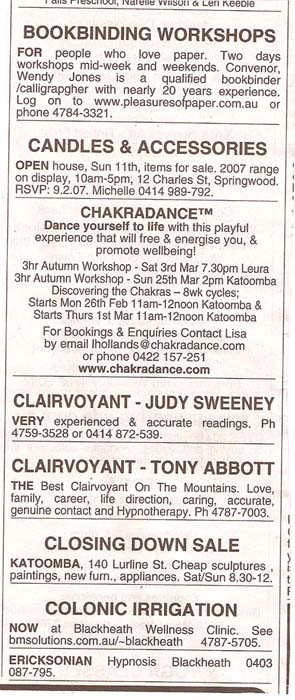 One definable group of visitors -- easily differentiated from the busloads of Chinese and Japanese package tourists -- are the backpackers and the rockclimbers. There are several hostels in town and a number of shops on the main street selling gear and offering tours and excursions to climbing and abseiling sites. In the Blue Mountains Gazette the other day, an article described a new attraction: the chimney climb at the Carrington Hotel. Its brick chimney, built in 1913 as part of the power plant for the hotel, is the highest point for many miles (see the watercolour at the top of this page); participants willing to shell out $125 will climb up the inside, then abseil from the top. And what do normal people do for fun? Not abseiling, but garage saling -- on Saturday mornings! For example, there is the Morris Minor of wheelbarrows for $25, below: 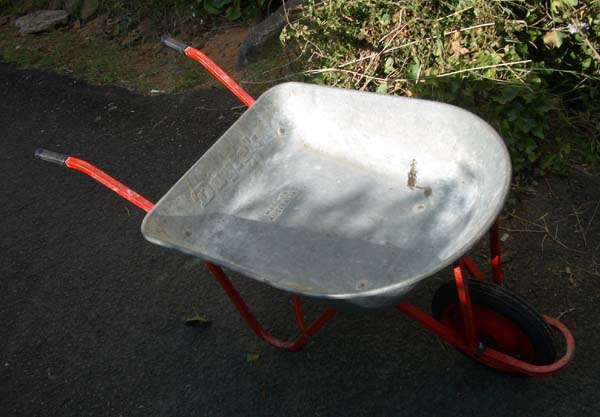 Although we arrived with just 2 suitcases each 3 months ago, we've now got a houseful of stuff. Garage sales, craigslist, rellies and friends of rellies in Sydney have all contributed their share. Everyone wants rid of something. Even the old things that seem so traditional to Australia (apropos of the comment that the country was built on beer, vegemite and galvanised iron) are for sale in the St. Vincent de Paul shop, cheap as chips like the pan below, swept away by the tsunami of goods from China via K-Mart. 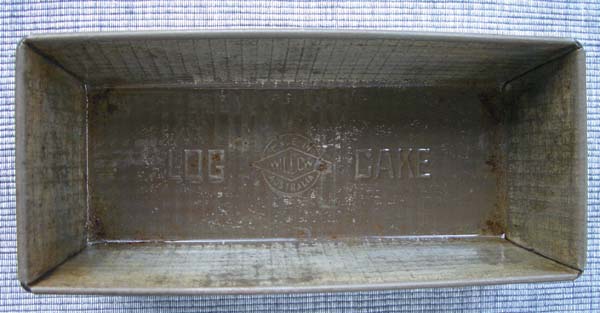 |
| February 18, 2007: Out
of curiosity, Christine spent a few minutes the other day looking at
Vancouver real-estate prices on the web. Typical was a beer-bottle
stucco bungalow catbox near 49th and Main, hardly a prepossessing area,
offered at $698,000. So prices are continuing upward, it seems. In the Weekend Australian,
an article noted that prices in Sydney were 16.3% below their peak in
2003, so they can also go down. Housing and mortgage costs in Australia's "two-speed economy" are seen as being a key election issue this year, as Prime Minister John Howard attempts to perform his Lazarus routine for a 4th time. The young families on the outer edges of the cities, sometimes called "the battlers," will determine a number of key seats. Labour has to win 14 more than it now has to gain a minority, 16 for a majority. In the Darwinism section of the paper, an article told of Adelaide painter Robert Hannaford, who lost his tongue to cancer due to his almost life-long habit of clamping paintbrushes, often charged with flake (lead) white or cadmium pigments, between his teeth. "I've always been interested in dying and death ... and this illness has been a great opportunity," he said. A painter who has come very close a number of times to winning the prestigious Archibald portrait prize, Hannaford has an even more serious problem: his realistic portraits and landscapes are "not fashionable in the art world." And in the P.T. Barnum section, called "Trends," a feng shui master named Joey Yap performed an audit of the home of a TV personality and his wife. The house attracted lots of Qi, or earth luck, due to its setting, but to be put completely right was going to require an illegal tree-lopping and the rearrangement of the couple's bedroom to reduce the possibility of friction and arguments. They were not to use the front door until next year when a negative star would have passed. So far so good, but they balked at the directive to drain and fill in the swimming pool, even though it might affect the relationship with their two children, both of whom are in their late twenties. The pool "has always been a unifying factor for us a family," said the owner. |
| February 16, 2007: Fine
weather since the deluge, and news that the level in one of the Sydney
dams went up 5%! Must be time to wash the car .... Differences and similarities, Australia and Canada: - a difference: politicians of all stripes here talk positively of the Australian-American alliance, Australia being part of the Iraq coalition and having sent troops to Vietnam, etc. Not that mainstream Canadian politicians are obviously anti-American, but you would never get a situation in Canada like the one that happened here the other day, where Prime Minister John Howard directly criticized Barack Obama's proposal to remove all US troops from Iraq on a tight deadline. People here were saying, well, what happens if the Democrats win in 2008? Mind you, Jean Chrétien said during the 2000 election campaign, "well, you know, we always get along better wit de Democrats .... ", so I guess this is a similarity. -it was heartwarming to read of another similarity between the two countries, on the matter of botched military procurements. Canada's two biggies have been helicopters and submarines, so you might guess that Australia's would be one or the other. Yes? Which one? Are there any hands going up for both? The Australian military's two biggest equipment scandals have been helicopters and submarines. Their Collins-class subs costs more than $1 billion to fix, including work to repair hulls. And, in the newspaper last weekend, the front page headline read, "Seasprite headed for the junk pile." "The navy's ill-fated Seasprite helicopter program is almost certain to be scrapped after a decade of problems, leaving taxpayers with losses of more than $1 billion." The Seasprites are Vietnam-era airframes that were to be refitted by an American company, Kaman, but have failed to meet airworthiness standards. The project is more than 6 years behind schedule. Included with the article was a small cartoon showing a lemon with a propeller; the defense minister is saying to the prime minister, "Maybe we could use it to treat scurvy?" |
| February 12, 2007: More
pictures of our new home and its surroundings are posted! As if in answer to the politicians seeking guidance to solve the water shortages caused by the drought, there has been an almost Biblical inundation, at least in our part of New South Wales. Flash floods, heavy showers, filling dams. Livestock swept away in a few places, where "we heven't seen ryne loik thet foah 30 oah 40 yee-ahs." Such a climate of extremes. Perhaps this is a hint for the politicians that timing is everything and the best action is no action at all, one they would gladly take. We here in Katoomba have had about 120 mm in the past day and a bit, the stormwater rushing down the lane past the house and into the gully, whence it quickly makes its way down to Katoomba Falls and into the catchment for the city of Sydney, 100 km away. The first time it rained after we moved here was about two weeks ago, following a spell of hot, dry weather. I awoke in the middle of the night to the sound of a shower on the trees in the garden and felt very contented, very peaceful. Magic rain, giving life back to the landscape. A few days before on a blazing afternoon in Sydney we had watched a hapless myna bird trying desperately to scoop up a bit of water from a tiny puddle, perhaps a spill from a hose somehow caught in a dent in a sidewalk. How do these creatures cope in such a harsh place? Yesterday morning it began to rain here, but more steadily, and the clouds were low, enshrouding the trees in the gully below the house -- we are at about 1040 metres elevation on the high mountain ridge, after all. There were swirls of mist like blowing smoke moving along the streets and the staccato rattle of raindrops against the windows. This was a melancholy, chilling rain, like the rains of Vancouver springs. The crimson rosellas perched quietly in the cherry tree, waiting it out. As if by perfect timing, a box of winter clothes and shoes had recently arrived, one we had mailed in late November just before departing from Canada. Ironically, in our last week in Vancouver there was heavy rain becoming slush, then snow, and all we had wear was sandals. Included in the box was the beloved Pirelli hot-water bottle, which had gotten us through 2 brutal weeks in a stone cottage in Provence in January, 1993. It was quickly pressed into service. Our home is like a Canadian summer cottage, in that it's built to let heat out rather than keep it in, so it's as cold inside as it is outside in the rain and cloud. Louvers instead of windows in a couple of places, and draft snakes -- the tubes of padded fabric meant to be kicked against the base of a door to keep out the cold winds -- at the front and back doors. But at least it is a traditional mountain home, with doors on the rooms so individual ones can be closed off and heated. Central heating in Australia is a rare bird. Nevertheless, we have some work to do weatherstripping and insulating before winter arrives. All of which made me reflect on the months since we left our Langley farm early last August, and the process we went through of settling, sort of, in the apartment on West 10th in Vancouver. We were subletting, it really wasn't our place, and so the noise of neighbours and the racket from the street didn't affect me at all. And we didn't have internet there, relying instead on local cafes like the charming Wicked at 7th and Hemlock with its comfortable chairs, strong coffee and fast wi-fi. 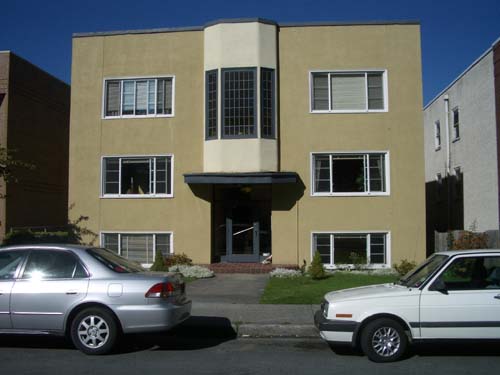 The
1945, 10-suite
walk-up neo-Deco apartment building in Vancouver at 1446 West 10th, a
half block from Broadway and Granville, where we spent the autumn of
2006 -- our window the middle one on the left. The equivalent of
hitting the reset button after leaving the farm and before moving to
Australia.
The idea that broadband internet access
is a such a
part of settling into a place is a bit unsettling, as it were. Why
can't I just go away and be away like I did years ago? What's the need
to be so connected? Why did the internet cafes of Cortona or Xania
always catch my eye? However, upon reflection I find I'm just doing
what people have done since the postal service was invented 150+ years
ago. Whether it was Ernest Hemingway or Aunt Louise, people have always
spent a huge amount of their time writing letters and postcards. In the
Hemingway biography I'm still slogging my way through, he is constantly
writing letters and it's a wonder he managed to write any stories. In
the research I did on Rogers family in Vancouver, it was clear that
everyone spent every available minute writing to each other. Technically, settling also requires a cat. But it's too soon here, we're coming and going too much, we haven't made any long-term decisions yet. So I have consoled myself with posting some pencil drawings of Mary Ann, our cat from the farm whose departure for a new home was one of the toughest parts of our move. |
| February 9, 2007: Most
of the news in the papers and on the radio concerns water (pronounced
"woddah") and the duck-shoving that has turned into a stoush.* In
response to the multi-year drought, the worst since the 6-year one that
immediately followed Australian Federation in 1901, Prime Minister John
Howard has proposed taking federal control of the huge Murray-Darling
river system, which is constitutionally in the control of the states
through which it passes, in return for heaps of cash. The
Murray-Darling drains much of central Australia west of the Blue
Mountains and provides water for the critical agricultural areas in
Victoria and South Australia, as well as providing Adelaide, at its
mouth, with a few drops to drink. After days of meetings, only New
South Wales, which is least affected by the Prime Minister's move, has
said it will sign on so far to the federal plan. It's interesting observing this because: a) they're fighting over constitutional powers, which makes me homesick for Canada, and b) although it's not directly related to climate change, it's forcing people to examine the impact of their lifestyles and the capacity of the environment to support them. A summary of the commentaries include: -individuals use a lot more water than they did generations ago. Daily showers, private swimming pools, dishwashers and washing machines far and away negate any gains made by, say, dual-flush toilets. -although the population of Australia has increased by about a quarter (pronounced "quoddah") in the past 20 years, there have been no major water projects, such as dams, built. Now there's a panic to provide "recycled water" aka cleaned sewage in the capital cities and/or to build desalination plants, in spite of their environmental consequences. This really reminds me of British Columbia, which has become a net importer of electricity in spite of its huge resources because of its failure to add to its infrastructure. -local governments are getting really serious about helping homeowners install rainwater tanks. We are investigating installing a large one here, and if we tie it in with the building's grey-water system (i.e. use the water for washing, etc. ) they will rebate us even more. -many people are questioning the irrigation licenses for crops like cotton and rice that draw a huge volume of water out of the Murray-Darling. -the drought a century ago hobbled Australia's agricultural-based economy, but has minimal effect on today's booming one. Why? Because Australia has become "China's quarry," with a mining boom fueled by high mineral prices. This is the most urbanized large country in the world, with more than 2/3 of the population living in capital cities, and they are mainly doing very well indeed. In fact, this is potentially the trump card for John Howard's Liberal government when it seeks a new mandate later this year, as in the famous "it's the economy, stupid" slogan. -a government task force is urging the creation of a carbon-trading network in Australia, a kind of home-grown Kyoto (sound familiar, Canada?). Local governments are also urging electricity conservation, including offering a complete (and free) evaluation and lightbulb-replacement for private homes. Any electricity savings have a direct impact on Australia's carbon emissions, because most of its electricity is generated by burning coal. [Later on the day I wrote this, a news story said that the state premiers, who are mainly Labour, are promising to start a carbon-trading system for the country by 2010 if the Liberal federal government hasn't picked up the ball.] -and finally, a consensus is emerging that the El Nino effect will be gone in a couple of months, leading to a La Nina scenario which will end the drought and bucket the place with rain. Just in time so the politicians can get back to duck-shoving. *
Duck-shoving is the
tendency of politicians to pass the buck back and forth without
accomplishing anything (it's getting bad when you have to use one
metaphor to explain another). A stoush is a fight.
|
February 8, 2007: And
today's topic is ... wildlife
photography with a cheap camera!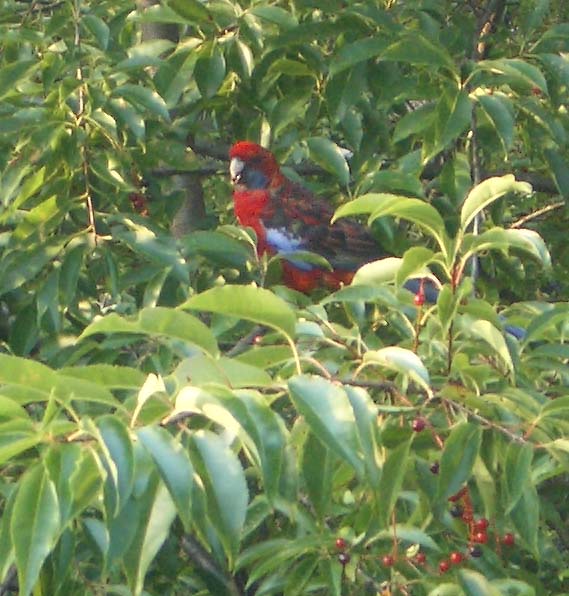 A crimson rosella in the cherry tree in the back garden. Usually a flock of a half dozen or so stop by to clean out the ripening small fruit, which is like the choke cherries of west coast [Canadian] meadows. At least I'm guessing the cherries are bitter -- I'll sample one after reading the fine print on my traveller's insurance. It amazes me how well these dazzling birds fit into the colours of the native forest, where the leaves have an undertone of rusty brown and there is blue-sky colour in the dappled shadows. Later, a flock of King parrots visited the gum trees at the bottom of the garden, too far away even to try to photograph; they are even brighter, with vermilion bodies and lime green wings. The rosellas are about 30 cm long, the King parrots about 40. 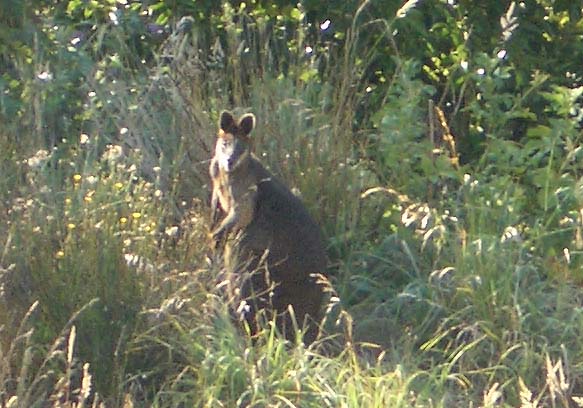 A wallaby, about a metre tall, in the scrubby grass of the vacant lot next door. He/she grazes in the morning and again at dusk, retreating in between into the deep shadows of the gully that runs along the bottom of our garden. And further to
matters of
wildlife, people have a love/hate relationship with the "cockies,"
which are incredibly destructive birds. Most of the fine detailing on
vintage Australian houses is in fact iron lace, rather than scroll-sawn
wooden fretwork, a fortunate historical accident due to the cockatoos'
enthusiasm for ripping apart anything wooden. And they are no
respecters of high culture, either: "Sculpture no match for winged
critics," writes Sarah Taylor in the Weekend Australian.
"Brett Whiteley's much loved and much loathed matchstick sculpture has
been given a thumb's down by perhaps the harshest critics Mother Nature
can muster -- a flock of cockatoos. The birds have taken to the
sculpture [outside the Art Gallery of NSW in Sydney] pecking it apart
and forcing gallery bosses to cover it until a restoration project can
begin ... For the 2nd time since the sculpture was donated ... by
Whiteley in 1991, the year before his death, the sulphur-crested
cockatoos have been unable to resist sharpening their beaks on the
burnt charcoal top of one of the matchsticks."
|
February 3, 2007: (this
is probably the only posting for a week or so, as we're still
struggling to get broadband in Katoomba) We've
moved to Katoomba, to the 1936 triplex originally known as the
Elizabeth Flats aka the Warialda Flats. I'll be posting a page soon of
interior photos, maps etc., but here's what it looks like: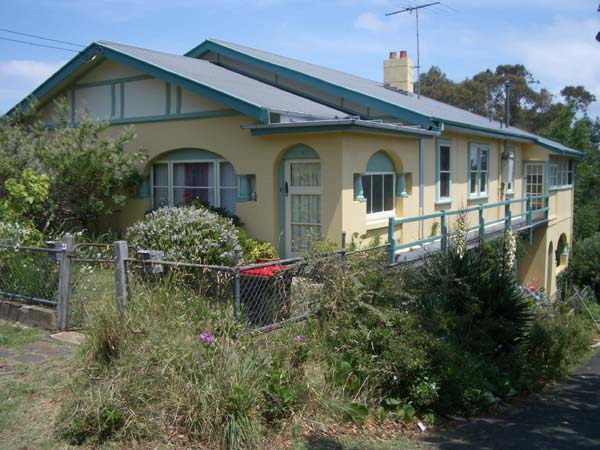 ... and we're
starting off in Flat
3, the lower one overlooking the back garden, whose entrance you can
see at the extreme right of the photo. From the street it's a low
bungalow in Arts and Crafts style with
mirror-image flats on the main floor divided by a central wall. As the
lot falls away quite steeply, there is Flat 3, the third 2-bedroom
apartment. Some of the rooms have elaborate art deco
plaster ceilings, cup rails and woodwork, and many of the windows are
beautiful leaded glass. All three have sunrooms lined with big old
sliding sash windows -- perfect south light for a painting studio! We
will be giving it some required TLC, live in one of the main floor
flats, leave the long-term tenant in the other, and rent out Flat 3 for
short-term "holiday lets."
The Blue Mountains lie just inland of the Pacific Ocean but actually form the continental divide. A spot west of Katoomba called Mount Victoria is actually the highest point on the rail line between the Pacific and Indian oceans. The Blue Mountains were first traversed by a road in the early colonial period, nearly 200 years ago, and when the railway went through a generation later people began to see the potential of its scenic spots and develop resort towns (Banff comes to mind). The first impression you get of Katoomba, especially from a place like Sublime Point, where I painted the watercolour above, is of an Italian or southern French hill town. Katoomba is the biggest of the Blue Mountains towns, with a population of about 8,000, I think. At its core is the railway station and, nearby, a large hotel called the Carrington built in the late 1870s. By a century ago a street of shops had developed near the station and hotel and a number of guesthouses, some quite grand, dotted the nearby streets among the smaller bungalows. Sydney is about an hour and a half away by car on the toll motorway, or 2 hours to Central Station by electric train (16 trips a day for less than $30 return fare). Almost every tourist in Australia comes here to see the view from Echo Point. The road and rail line are a corridor through the middle of the huge Blue Mountains National Park, a UN World Heritage Area. Unlike, say, the Rocky Mountains, where the corridors follow the valleys, in the Blue Mountains the corridors follow the tops of the ancient, eroded mountains. The towns sit high on these "benches" that end with shear sandstone cliffs dropping 1,000 feet or more into the valleys, and look out over an astonishing sea of dusky blue-green eucalyptus forest. Somehow it reminds me of the best of the Gulf Islands, except much more dramatic with a different colour of sea. And yet Katoomba, with its fine collection of architecture, is more like Nelson in the Kootenays. To continue the comparison, the Blue Mountains has the same sort of diverse population as the Gulf Islands or the Kootenays -- old money, retired people, aging hippies, the permanently unemployable, backpackers, rock climbers. The oldest organic food co-op in Australia is in Katoomba (yes, we've joined). Our back garden ends at a gully full of gum trees that is a "Council Reserve" due to the stream path at its bottom. Flocks of birds, including rosellas (red parrots with blue wings) and cockatoos, mostly the white-bodied, sulphur-crested ones but a few of the larger, yellow-tailed black ones that look like turkey vultures in flight and have a cry like a bald eagle's, hang out in the trees. There are local magpies and currawongs whose carolling is a pleasant contrast to the raucous squawking of the "cockies." Apparently, a half century ago, there was a view from here all the way to Mount Solitary, which stands in the Jamison Valley to the south (left) of the "Three Sisters" in the watercolour above. But all the trees have grown up since. |
Return to home page